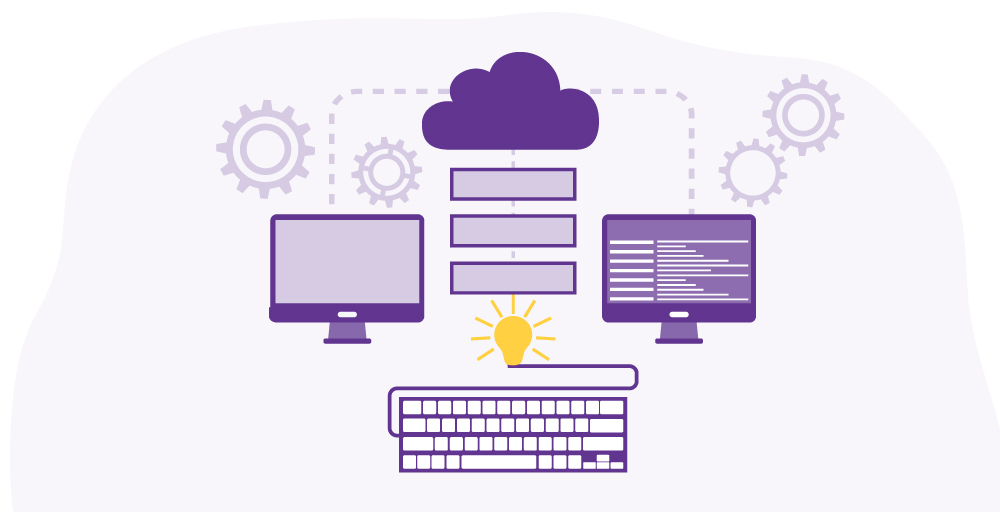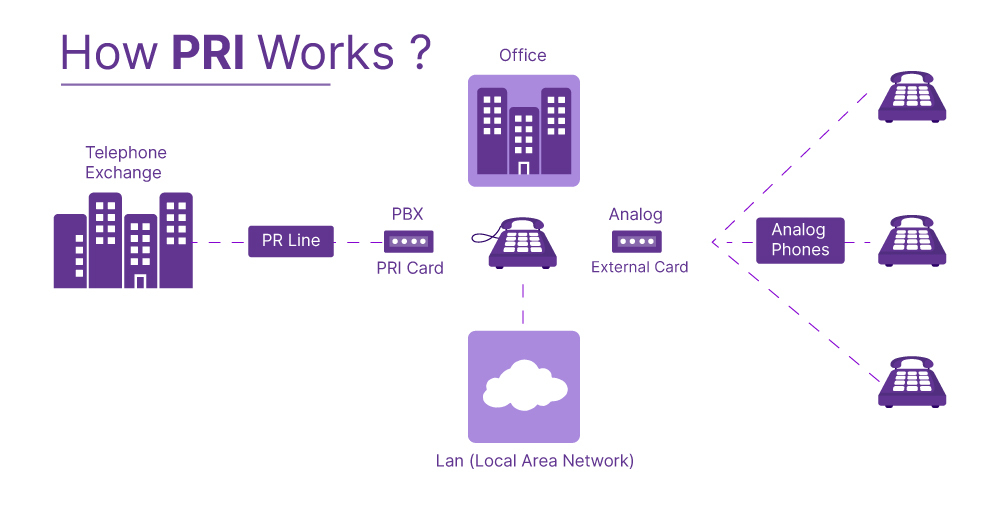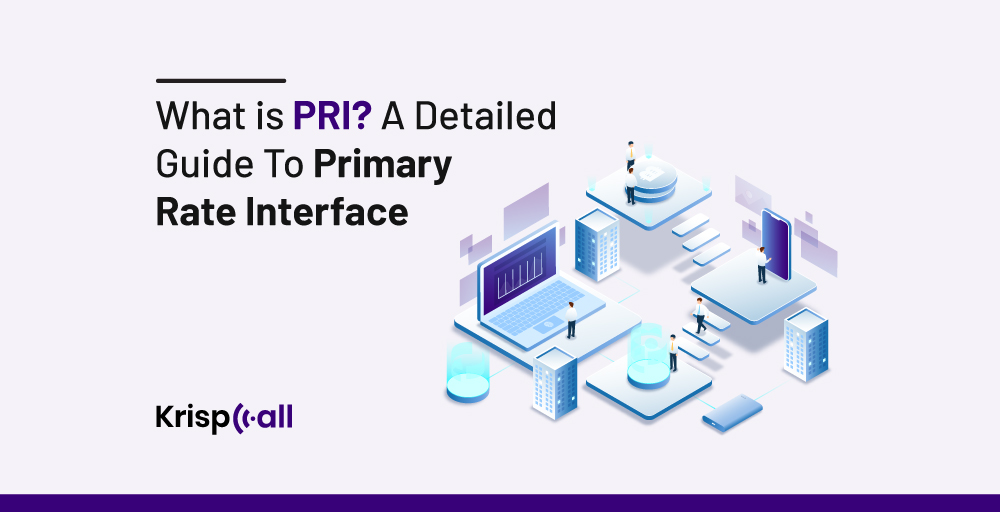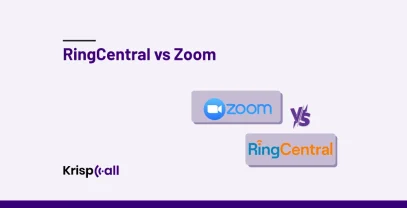Are you running a business that receives a lot of phone calls ☎️? In that case, Regular phone lines might not be enough.
That’s where PRI comes in. It is a multi-lane highway 🛣️ for phone calls!
PRI bundles several phone lines into one connection, enabling businesses to handle multiple calls simultaneously. With PRI, you can get robust telecommunication solutions that assure reliable, high-quality voice and data transmission.
PRI might not be new to you, but you may not know enough about it. So, Let’s explore how PRI works, its features, benefits, and drawbacks, and whether it’s the right choice for your business or not.
🔑 KEY HIGHLIGHTS
- Primary Rate Interface connects Private Branch Exchange (PBX) to the Public switched telephone network (PSTN), which provides voice and data transmission services.
- There are 2 types of PRI lines: the T1 Trunk line and the E1 Trunk line.
- Some of the reasons for using PRI systems are clear communication, cost savings, high call volume, and security.
- Some of the features of PRI are multiple channels, direct inwards dialing, caller ID, flexible configuration, high capacity, and communication features.
- Some of the major benefits of the PRI system are Cost-Saving, High-Quality Voice, Scalability, Feature-Rich, Reliability, and Security.
- Drawbacks of the PRI system include Higher cost, geographic limitation, wasted capacity, and hardware dependence.
- Alternatives for PRI are Analog POTS lines, SIP Trunking, and Hosted VoIP.
What is Primary Rate Interface (PRI)?
Primary Rate Interface (PRI) is a telecommunication interface standard that delivers voice and data services between devices within a single connection. PRI is an Integrated Services Digital Network (ISDN) line that connects a Private Branch Exchange (PBX) to the Public switched telephone network (PSTN).

This standard mainly focuses on providing services for larger enterprise users or businesses. Organizations use PRI to link their phone systems to the PSTN or to connect multiple PBXs within an Organization. It provides a bunch of phone lines in one connection.
PRI Lines is a primary rate interface phone service that relies on a physical network of copper wires, which are the individual channels that makeup PRI Service. PRI Line has 23 B channels for voice and data and 1 D channel for call control and information, for a total of 24 channels.
Types of PRI lines
There are two main types of PRI lines categorized on the basis of geographical location.
1. T1 Trunk Line
T1 Trunk Line is the common PRI line primarily used in North America and Asia. It consists of 24 channels in total, of which 23 channels are for voice and data, and 1 channel is for call Identification. These lines are mainly used for voice calls and data transmission.
Most businesses and organizations use T1 Trunk lines to connect to the public switched telephone network (PSTN). These lines are known for their reliability, high-speed data transmission, and ability to handle multiple voice and data channels simultaneously. It carries the data at the rate of 1.544 megabits per second.
2. E1 Trunk Line
E1 Trunk Line is a type of digital PRI connection that is commonly used in Europe and many other parts of the world. It consists of 32 channels in total, of which 30 B channels are used for voice and data transmission, and 2 D channels are for call identification and signaling.
It has a higher bandwidth rate of 2.048 Mbps than that of the T1 Trunk line. As a result of higher bandwidth, it provides a higher capacity for data transfer. Moreover, E1 trunk Lines are mostly known for consistent communication quality.
Reasons to use PRI for Business
PRI provides a quality communication mechanism for businesses to communicate and transmit data. PRI offers various compelling reasons to enhance communication quality.
1. Clear Communication
PRI ensures the finest voice quality over other traditional communication lines and clear professional communication with clients and colleagues.
PRI uses digital signal processing (DSP) technology to convert analog voice signals into digital signals. This converts your voice into digital signals before it’s transmitted to the other end. Digital signals are less likely to disrupt than analog signals, so reliable communication with reduced background noise can be guaranteed with PRI.
2. High Call Volume
Handling a large number of calls simultaneously with traditional phone lines has never been easy. However, PRI provides 23 B channels that act as a highway for phone calls, helping businesses keep up with the high volume of calls.
It provides an efficient call-handling mechanism through increased capacity for high call volumes, so no calls are missed or no sales opportunities are lost.
3. Cost Saving
Using PRI can reduce costs and benefit businesses with high call volumes. Compared to having individual phone lines, it reduces the cost of maintaining high call volumes.
As the single line can handle the load of 23 to 30 individual lines. This directly lowers the cost of services by reducing per-minute charges compared to having individual lines.
4. Security
PRI provides an encryption mechanism to secure the transmitted data between two ends. Unlike other communication systems, PRI provides a dedicated connection, which reduces the risk of invasion.
PRI Line makes it impossible for intruders to listen to or breach conversations by using various security measures like authentication, access control, intrusion detection, firewall, etc.
How does PRI work?
A PRI works by allowing businesses to add 23 lines for dialing configuration. Sometimes, businesses need more lines as their requirements increase. In that case, more lines are added up to 30, as is the case for the E1 channel.

PRI allows someone from outside to contact employees directly on their direct number. The company can use these employee direct numbers for different individuals in the company, reducing the need for a physical phone circuit.
Unlike VoIP, PRI doesn’t depend on internet bandwidth, which can help them upgrade their phone system quickly. Also, if 23 calls utilize the primary PRI circuit, the company can add a second PRI to double the capacity to 46 calls.
Features of a Primary Rate Interface
PRI Lines offers a variety of features to make the communication process efficient and reliable. Let’s talk about some of the features of a primary rate interface.
- Multiple Channels: PRI consists of multiple channels used simultaneously for communication purposes. A PRI line supports 23 B channels and 1 D channel, which provide multiple channels for data transmission, enhancing data transmission and improving communication.
- High Capacity: As we know, PRI supports multiple channels, 23 B channels for voice and data communication, considerably more than any other type of ISDN service. Likewise, PRI has a high capacity to handle large numbers of calls simultaneously.
- Direct inwards dialing (DID): Direct inward dialing empowers customers to reach the specific person or department within the organization directly. This reduces hold times, as customers don’t have to wait in queue to reach the person they want to talk to.
- Caller ID: PRI supports Caller ID, mainly used for business purposes. It allows the receiver to identify the caller by seeing the caller’s phone number and name. Businesses can also use it to promote their brand by adding a logo or brand name as their Caller ID.
- Flexible Configuration: PRI is a reliable and flexible solution that allows businesses to handle multiple calls simultaneously. It provides 23 different data and voice channels for transmitting voice and data simultaneously.
- Communication Features: PRI allows voice calls and data transfer through a single line. It offers various advanced telecommunication features, such as Caller ID, Call Forwarding, Call Waiting, Conference Calling, Voicemail, etc.
Benefits of PRI lines
With modern telecommunication systems marching in the business world, Advanced telecommunications systems have replaced PRI. However, many businesses still use this technology as it provides numerous benefits. The benefits of using PRI lines include:
- Cost-Saving: PRI can be a cost-saving solution for businesses that have to deal with high call volumes. As PRI lines offer multiple channels in a single line, they are less expensive than having multiple individual lines as in a traditional system.
- High-Quality Voice: The PRI system converts analog voice signals into digital signals and transmits the voice digitally. It enhances high-quality communication by providing a clear connection without external interference.
- Scalability: In PRI lines, you can easily add or remove channels. Mostly, the businesses that require increments in call volume or channels use PRI as you can easily add more channels and handle multiple calls simultaneously.
- Feature-Rich: PRI lines also offer various telecommunication and telephony features, such as caller ID, call forwarding, call waiting, conferencing, and direct inward dialing. These features ease a business’s call services by enhancing productivity and customer service.
- Reliability: PRI lines provide dedicated channels for voice communication and data control that maintains reliability and stability of the communication. By maintaining call quality businesses can easily cope during peak hours.
- Security: PRI primarily focuses on maintaining data integrity and security. To ensure the security of sensitive voice and data transmission, PRI lines offer enhanced security features, such as channel encryption and authentication.
Drawbacks of PRI systems
The PRI system has been used as a reliable telecommunication solution for businesses, but its use has been degrading nowadays. Despite having numerous benefits that suit business telecommunication needs, it also has certain drawbacks that companies should know about.
By understanding those drawbacks, businesses can consider whether this system can fulfill their requirement.
- Geographic Limitation: Local or Regional telephone companies provide PRI systems, which are not accessible to individuals in other geographical regions. Companies with major branches in different locations might have to install separate PRI lines, which can be hectic.
- Wasted Capacity: For a small business that doesn’t require all 23 channels, it can be a waste if you don’t need all the capacity. You have to pay for all the channels, even if you don’t use all the channels, which increases your communication costs.
- Hardware Dependent: PRI systems depend on hardware like PRI cards and PBX equipment to connect business telephone systems to PRI lines. Because of this dependency, the initial or maintenance cost is relatively higher than for other telecommunication systems.
- Complexity: Initial setup and maintenance can be more complex for PRI than for other VoIP systems. An IT team or technical experts are mostly needed to provide a reliable PRI system.
Alternatives to PRI lines
PRI is a well-established communication technology that offers reliable voice and data transmission. These services have changed how today’s businesses communicate with customers. New advanced telecommunication technologies have left PRI behind as the communication world is heading towards more advanced technologies. Each technology have several respective benefits.
As a telecommunication service, PRI has evolved into a reliable and cost-saving solution for providing communication services. However, it does not meet the requirements of advanced telecommunication technologies. Businesses are exploring for better alternatives to PRI. Let’s discuss about some of the PRI alternatives.
1. Analog POTS lines
POTS (Plain Old Telephone Service) is an analog voice transmission system that is mainly known for direct connection. In this system, Copper wires carry your voice from one location to another. You may have heard the word landlines or PSTNs. POTS lines are often referred to as landlines or PSTNs.
POTS lines have been a conventional communication system for over a century, but they require a lot of hardware equipment and frequent maintenance. However, with the advancing telecommunication systems, it’s hard for this traditional system to keep up with the modern needs and demands of the business, so it has been replaced by modern systems.
As the POTS lines are mostly used to handle one call at a time. Areas with limited access to advanced infrastructure or internet access mostly use this system.
2. SIP Trunking
Session Initiation Protocol (SIP) is the process of transmitting voice and other unified communication services using SIP protocol over the internet. Instead of using copper lines or physical means, it routes the call and data over the internet.
SIP Trunking is the modern alternative to Analog POTS lines or other traditional phone lines. It provides businesses various communication functionalities, compelling them to use it over other systems.
SIP supports various advanced telecommunication features over traditional systems, such as videoconferencing, unified communication, mobility features, advanced call routing, etc.
3. Hosted VoIP
Voice over Internet Protocol (VoIP) uses the internet to transmit voice and data, similar to SIP Trunking. These two technologies are quite similar yet different. SIP Trunking provides connectivity between endpoints and cloud-based communication services that enable communications over IP networks. At the same time, VoIP is a cloud phone service that allows voice calls over the Internet.
In Hosted VoIP, the service provider handles the overall communication features using the Internet. It is an internet-based telephony solution provided and managed by a third party.
Hosted VoIP offers several advanced features over traditional phone systems, such as Auto Attendant, Call Routing, Voicemail, Softphone, Virtual Phone Numbers, Call Recording, and Call Forwarding, making it a reliable choice for businesses.
PRI Vs SIP Trunking Vs VoIP. What is the difference?
Nowadays, Businesses have various options for simplifying their communication services. But Choosing the right one has been an issue.
You can choose the right telecommunication system depending on your needs and requirements by looking at the table below, which compares the prevailing technologies.
| Features | PRI | SIP trunking | Hosted VoIP |
| Technology | Traditional Analog Technology | Uses Session Initiation Protocol | Uses VoIP |
| Setup Cost | Expensive to handle high call volume | Cost-effective compared to traditional line | Typically cheaper than traditional lines |
| Call Quality | Generally good, but can be affected by external factors | High Quality (Dependent on Internet Connection) | High Quality (Dependent on Internet Connection) |
| Number of simultaneous calls | Fixed (Typically 23 Channels) | Scalable | Scalable |
| Maintenance | Requires high maintenance | Moderate | Low |
| Flexibility | Limited | Moderate | High |
| Reliability | High (Lines Offers reliable connection) | Moderate (Reliable on Internet Connection) | Moderate (Reliable on Internet Connection) |
Switch from PRI to VoIP: Upgrade your business phone line to the cloud
PRI provides a proper solution for businesses to simultaneously handle large volumes of calls. However, it has been less relevant nowadays as new advanced technologies provide more robust telecommunication features than PRI.
Voice over Internet Protocol (VoIP) is a cloud-based phone system that provides a unified communication platform over the Internet. Cloud-based VoIP systems offer more flexibility and scalability than traditional telephone lines.
Switching from PRI to VoIP can benefit your business if your call rates are not static and if you see your business growing. VoIP systems offer various features over PRI systems. It modernizes the business’s working mechanism by improving its communication system and adding various tools and features to ease communication.
VoIP offers a flexible, lower-cost approach compared to PRI. Unlike PRI, where you must pay for fixed channels, you can pay only for the features and calls you perform.
PRI requires adding additional lines to scale the call capacity, which is complex and requires technical experts’ support. In contrast, with VoIP, you can simply increase or add new lines as required, which is beneficial for growing businesses.
Many businesses have switched to cloud telecommunication systems in recent years, as they provide advanced telephony features, such as call forwarding, call monitoring, auto attendant, IVR, autodialer, simultaneous ringing, etc, to help businesses improve their communication process.
Using a cloud-based telephony system like KrispCall can help Businesses switch from PRI to VoIP, improving their communication infrastructure, efficiency, and integration capabilities.
Final Thoughts
PRI provides multiple channels in a single line, enabling multiple calls to be handled simultaneously. PRI has been a robust and reliable telecommunication technology for over a decade.
It has evolved from the way traditional phone systems handle multiple calls. However, its use has gradually decreased. To cope with the advancing world of telecommunication and easy internet access, Businesses are approaching finding the best alternatives like Analog POTS lines, SIP Trunking, and Hosted VoIP for PRI. However, it is essential for businesses to know what system best suits their needs.
This approach has swiftly increased VoIP systems usage in businesses, as they offer reliable and scalable cloud telecommunication features.
FAQ
Does PRI use Internet?
No, PRI doesn’t use an internet connection; it relies on a dedicated physical connection.
Is PRI analog or digital?
PRI is a digital telecommunication interface that transmits voice and data over a physical connection.
Does PRI require PBX?
PRI typically requires a PBX (Private Branch Exchange) system to manage incoming and outgoing calls.
What is the data rate of PRI?
The data rate of PRI (Primary Rate Interface) is 1.544 Mbps (megabits per second) for T1 lines and 2.048 Mbps for E1 lines.
What are the differences between PRI and BRI?
The differences between PRI and BRI are:
| Features | Primary Rate Interface (PRI) | Basic Rate Interface (BRI) |
| Capacity | Higher | Lower |
| Number of channels | 23 B, 1 D | 2 B, 1 D |
| Usage | Large Business | Small/medium business |
| Simultaneous Call | High | Low |
| Bandwidth | Greater | Limited |
How many channels are present in PRI?
PRI typically consists of 23 B (Bearer) channels for voice or data transmission and 1 D (Data) channel for data controlling.
What is the use of PRI card?
Primary Rate Interface Card (PRI card) is a hardware component used to connect PRI lines to a telecommunication network.





